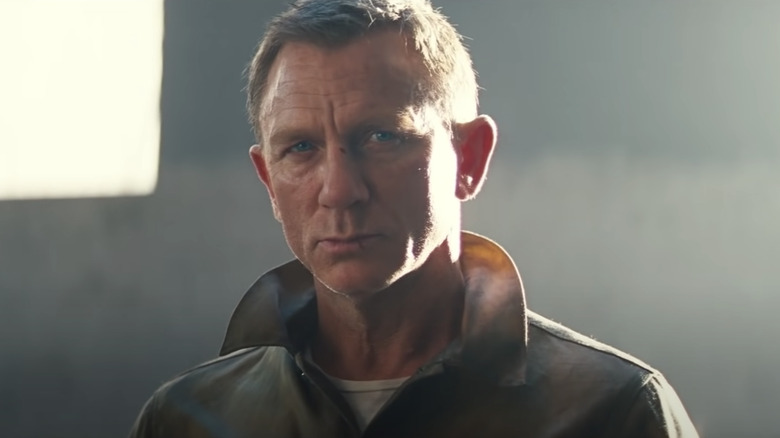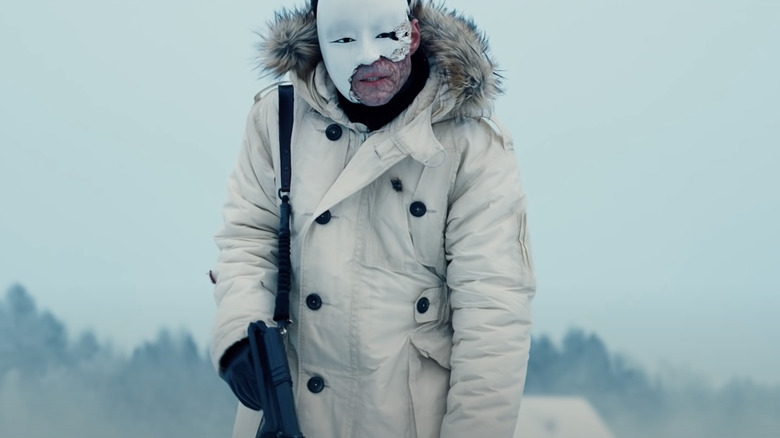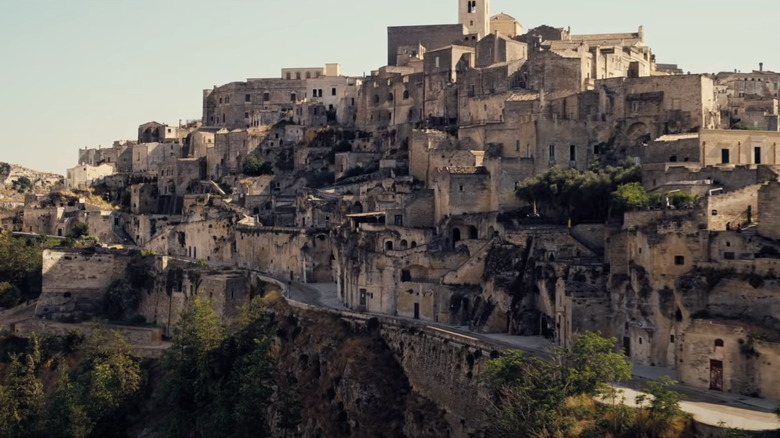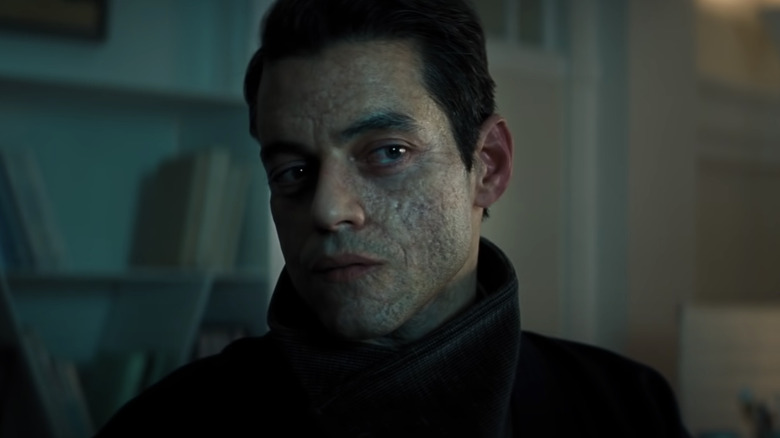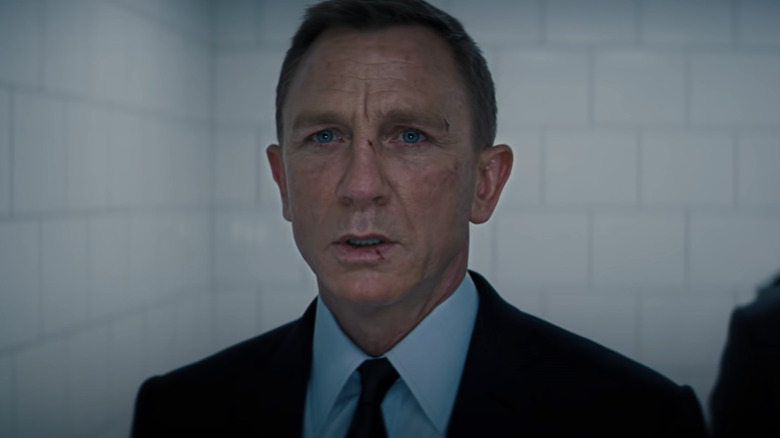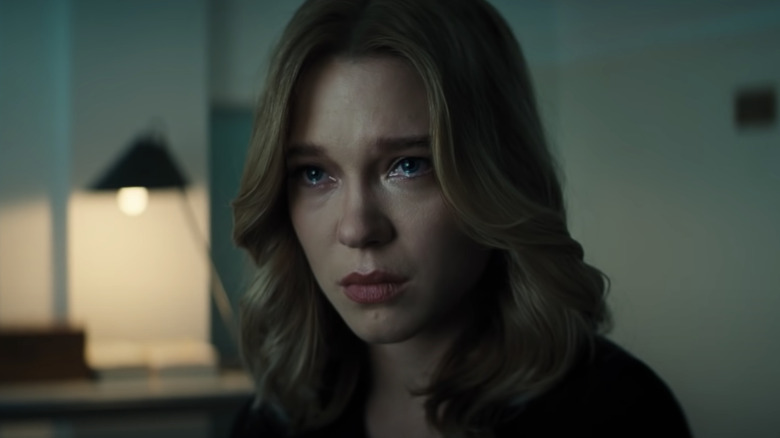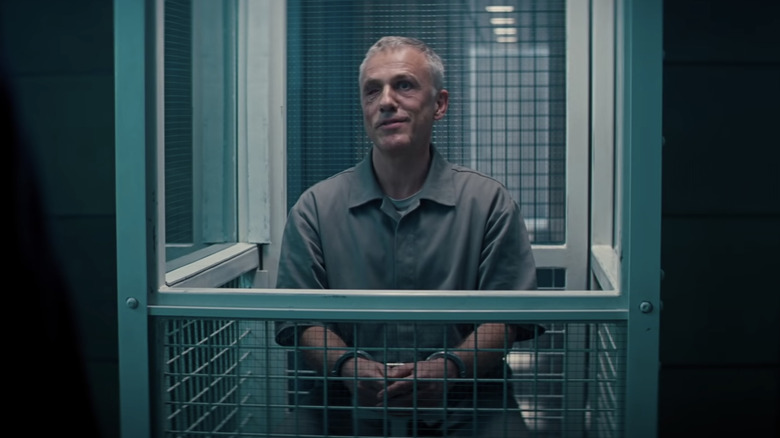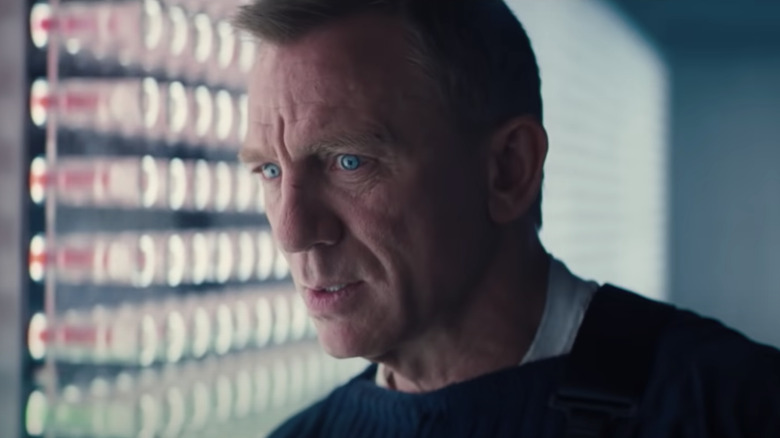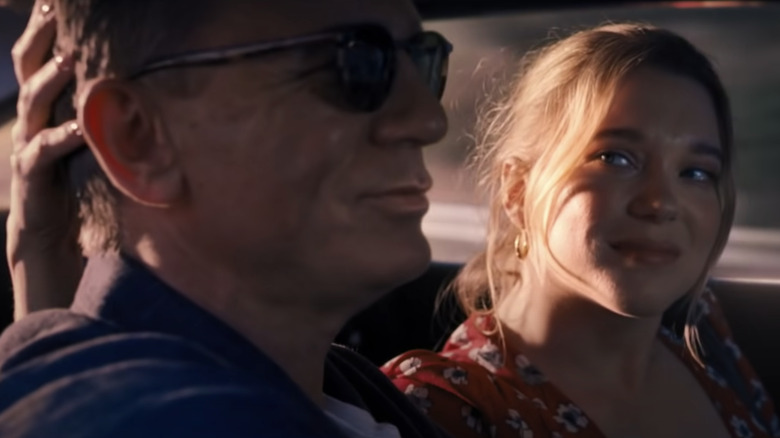No Time To Die Spoiler Review: Daniel Craig's Final Outing As James Bond Strives For Closure
"No Time to Die" comes 15 years after "Casino Royale," arguably the best James Bond movie. 2006 introduced the world to a rising star named Daniel Craig, who was known for his work in films like "Road to Perdition" and "Layer Cake," but who had yet to really break out and become a household name. Since then, we've been adventuring through the typical franchise peaks and valleys with Craig's Bond, and now, we're here at the end.
And it does feel like the end. Craig and all involved have made no secret of the fact that "No Time to Die" is his last hurrah as agent 007. Next year, Bond will be celebrating his diamond jubilee, like the Queen of England was back in 2012 when London was hosting the Olympics and Craig parachuted out of a helicopter with her. We'll most likely be marking the occasion with some casting news about who the next James Bond is going to be.
For now, there's "No Time to Die." Bond is one of Britain's most famous cultural exports, an almost 70-year-old institution, if you go back to the publication of Ian Fleming's first novel. However, in "No Time to Die," he's got an American director, Cary Joji Fukunaga, steering his mission for the first time. It's just one of the ways that this 25th film in the Eon Productions series feels different than any Bond movie we've seen before. That is not to say that it refrains from adhering to familiar franchise tropes. It's just to say that it makes some rather bold creative decisions.
We're about to parachute into full spoilers, so if you haven't seen "No Time to Die," please avail yourself of our non-spoiler review, and go no further here.
Of Death and Daughters
James Bond is dead. But James Bond will return. "No Time to Die" makes the unprecedented move of having Craig's Bond go out in a hail of missiles. When it happens, he's alone on an island, much like Luke Skywalker in "Star Wars: The Last Jedi," a reference that is sure to engender no ill will from any fans or Russian trolls of the kind a Cold War relic like Bond might fight.
Bond leaves behind a daughter, who has his eyes. It's tough to know this soon out of the gate whether big swings like these will make "No Time to Die" as polarizing as "The Last Jedi" was. Our own aforementioned non-spoiler review called the film a "definitive, divisive ending," so maybe that's an early indication or maybe we'll get lucky and this one will prove less contentious. What's clear is that Craig is jockeying for closure, and he's left us with a five-film saga that does have a concrete beginning ("Casino Royale"), middle ("Skyfall"), and end ("No Time to Die"), with a couple of lesser movies in-between.
The end begins with a God's eye view of a snowy forest. Another surprise is that "No Time to Die" starts out like a backdoor horror film. It's got a masked home invader with the unsubtle name of Lyutsifer Safin — just call him Lucifer Satan — bearing down on a little girl and her mother with all the determination of death itself. Were he not a Bond villain, he could almost be one of "The Strangers."
What separates him from them and their ilk is that he's played by Oscar winner Rami Malek, and he also has mercy enough not to let the little girl die in the frozen lake outside her house.
Bond's Last Supper
"No Time to Die" cuts from that little girl in the ice, who was rather handy with the handgun, to Madeleine Swann (Lea Seydoux) with Bond in the present. Lest we forget, she's the daughter of Mr. White, the recurring character played by Jesper Christensen in three of the five Craig films. He killed Safin's family, so then Safin revenge-killed his wife to make him suffer. Safin wavered but ultimately decided to spare Madeleine, and he will come back to haunt her later.
Madeleine and Bond still don't have the chemistry that he and Vesper Lynd, Eva Green's character in "Casino Royale," did. Their relationship lacks that special pizazz, and when Ana de Armas shows up later for a brief "Knives Out" reunion, you almost wish he would run away with her, because she seems like a lot more fun. On the whole, though, I found the Bond-Madeleine pairing more believable here than in the previous film, "Spectre," maybe just because they've settled into their relationship and she's not the new girl anymore.
They're in the hill town of Matera, a stunning location in Southern Italy where cave dwellings now serve as bookable rooms in real life. It's where "The Passion of the Christ" shot its Last Supper, which is fitting, since this is Bond's. There's some sort of local tradition that involves writing wishes and secrets and burning or sharing them; Bond writes, "Forgive me," as his message and takes it to Vesper's grave.
He still hasn't let go of her, and Spectre's wiggly tentacles still haven't let go of him. They've left their calling card on her grave. We get a jump scare, another slight shade of horror, as her tomb explodes and knocks the sound out of Bond's ears.
Bad Guys and Goodbyes
Bond and Madeleine have already been looking over their shoulder, so when a goon with a bionic eye shows up and tells him she's a "daughter of Spectre," it breaks his trust in her.
Many Bond baddies have a physical abnormality, a third nipple or some other easily identifiable quirk. The classic example would be Richard Kiel's Jaws and his steel shark-biting teeth. In "Casino Royale" alone, there was a guy with a burned face, one with a glass eye, and another one with an eye patch. Here, we have Bionic Eye Guy and Safin with his scars and "Phantom of the Opera" mask. This is one example of a way that "No Time to Die" still plays to convention.
The welcome exception to the rule is the smiley Mormon CIA agent, Logan Ash (Billy Magnussen), who materializes later with a returning Felix Leiter (Jeffrey Wright). Felix is not long for this world, because the clean-cut Logan is bad, too, and he'll be shooting Felix and leaving him to drown on a sinking ship. But we're getting ahead of ourselves.
Back in Matera, there are motorcycle stunts happening. Bond helps Madeleine escape in his bulletproof Aston Martin, but then he puts her on a train and says she'll never see him again. This moment, with her in tears moving along the inside of the train, looking out the window at him before he turns his back on her, is well done and wrought with emotion.
The horror-movie cold open and Matera intro unfold pre-credits, before the main title sequence where Billie Elish's somber "No Time to Die" ballad plays out over an Ozymandias-like scene, with a fallen statue in the sands of an hourglass.
Bond Goes Viral
"No Time to Die" gets off to a thrilling start and finishes strong, but somewhere in the middle, you begin to feel the weight of its 163-minute runtime. That said, as I sat there in the theater, taking notes, I found myself getting swept up in the movie, giving my pen a rest and just enjoying the big-screen spectacle. It was the first time for me to venture out to the theater since Christopher Nolan's "Tenet" over a year ago, and the movie lingered in mind for days afterward.
In lieu of continuing scene-by-scene, doing an inane recap, maybe we can just address some of the major elements of "No Time to Die." Producers and franchise shepherds Barbara Broccoli and Michael G. Wilson recently revealed the two questions they ask before going into a new Bond movie, and one of those was, "What is the world going to be afraid of in two or three years when the film comes out?"
Having Bond try to save the world from a virus — in this case, one powered by nanobots — definitely taps into real-world fears. I've said it elsewhere but the title of "No Time to Die" almost sounds like a message about moviegoing in the age of Covid.
This movie was one of the first tentpoles to get delayed at the outset of the pandemic, and we've heard from Fukunaga that he was doing rewrites while they were shooting and even after. We have no way of knowing how much of the movie might have been changed to hold up more of a mirror to reality. But its central conceit — Bond racing to save the world from a virus — does lead to an interesting scenario where he has to self-isolate to protect people.
Thoroughly Modern James
In "No Time to Die," people have become the weapon, their bodies acting as carriers for the nanobot virus, which can target the DNA of specific individuals. The movie jokes about bioweapons (a "misplaced tub of weaponized smallpox"), but it also finds time to indulge in a few old-fashioned puns, with Bond saying he blew Bionic Eye Guy's mind and gave him an "eye-opening experience." Felix has a "feeling in his gut" after he's been shot in the gut.
These and other flourishes, like an island base and a vehicle that transforms into a submarine (this time, a glider instead of a Lotus Espirit) harken back to the spirit of earlier Bond adventures. Yet "No Time to Die" also makes a few progressive moves that remind us we're watching a thoroughly modern Bond movie.
M (Ralph Fiennes) drops an f-bomb and Q (Ben Whishaw) appears to be gay, expecting a same-sex dinner date before Bond and Moneypenny (Naomi Harris) drop in on him. We meet Q's furless cat, and there are double the 007s in this movie, as Lashana Lynch's Nomi has taken over Bond's code number in his absence. It's worth mentioning that "No Time to Die" has a five-year time jump.
In its continuing bid to have, well, continuity, the Craig era asked us to believe in "Spectre" that Ernst Stavro Blofield (Christoph Waltz) was Bond's foster brother and the one who orchestrated everything that happened to him in the previous three movies. That felt like a retcon, just as it does when "No Time to Die" pulls the old switcheroo — twice — and infects Blofield and all of Spectre with the nanobot virus. Happy birthday, Blofield?
The Tentacles of Spectre (and Other Blockbusters)
It feels like Spectre and its Quantum division, all those Illuminati-like figures at the opera in "Quantum of Solace," never really rose to the occasion of being the invincible masterminds they were supposed to be. "No Time to Die" promptly kills Blofield and the rest of them off in the mode of other blockbuster franchises, which have tried to do damage control on ideas that proved unpopular.
Again, "Star Wars" comes to mind, though Blofield/Franz Oberhauser himself was a character once mired in the unsuccessful John Harrison/Khan Noonien Singh school of secrecy per "Star Trek." I mentioned Nolan, also, and one little thing that took me out of "No Time to Die" was when it started giving me some serious musical déjà vu. My brain asked, "Where have I heard this music?" Slow to catch up, it suddenly remembered that Hans Zimmer was the film's composer.
"No Time to Die" poaches Nolan's frequent collaborator, and while Zimmer leans on familiar Bond cues, there are definitely other hints of his own past work laced throughout the movie. In particular, there comes a moment toward the end where Q, Bond's "guy in the chair" (shout-out to Spider-Man's best friend, Ned Leeds), is remotely guiding our hero through the levels of a facility teeming with bad guys.
Keeping in mind that Lucius Fox is Nolan's version of Q, I couldn't help but flashback to "The Dark Knight" during this scene, especially with Zimmer providing the soundtrack. In his own movies, Nolan has pulled extensively from Bond, lifting the plane sequence from "Licence to Kill" and the snow fortress from "On Her Majesty's Secret Service." "No Time to Die" returns the favor by giving Bond a nuclear sendoff.
The Death of James Bond
It seems like the new out for actors like Craig and Robert Downey, Jr. — who are ready to be done with long-held franchise commitments — is to have their characters killed off at the end so there's no chance they can return. This is something "The Dark Knight Rises" toyed with: crystallizing the mortality of an iconic hero. As was his wont, Nolan's film went for the open, "Inception"-style ending. Maybe Batman lived, or maybe his faithful butler, Alfred, just imagined him there in that European café.
Nomi gives us a hint that the title of Bond 25 is false advertising when she quips, "Do you know what time it is? Time to die!" As it becomes clear that the film is working up to Bond's death, it lands like a soft surprise. It didn't leave me shaken in the martini way ... maybe a little stirred? I thought it was staged well enough and I appreciated that they went for it and gave us something different, something that had never been done in a Bond film before.
Bond tells Madeleine and his blue-eyed daughter, Mathilde, "I'll be just a minute," but we know that's not true as he watches their boat fade into the light. His final confrontation with Safin leaves him infected with the nanobot virus, a danger to them should he ever leave the island. After Safin shoots him and he shoots and kills Safin, Bond limps up the stairs, dripping blood. He's human, after all, and that's always been the best thing about this iteration of the character.
Wouldn't you know it, Bond's at his best when he's vulnerable, when he makes himself emotionally available to women, not just lovers but daughters and mother figures: Vesper, Madeleine, Mathilde, and Judi Dench's M.
Too Busy Living to Die
If Safin is Satan, then in "No Time to Die," Bond becomes yet another in a long line of improbable cinematic Christ figures, sacrificing himself like Iron Man to save others from certain death or thanatos. The nukes rain down on him, and this is his curtain call, the final moment of the final mission.
For me, "No Time to Die" lands firmly in the middle of the five-movie layer cake (pun intended) that is the Craig cycle. I would rank it ahead of "Spectre" and "Quantum of Solace" but behind "Casino Royale" and "Skyfall." It's a serviceable Bond film that runs a little long but is elevated by its denouement. If nothing else, it gives Craig's Bond a note of finality to close off the orchestra-rock sounds of his origin.
Old friends gather round to toast Bond at MI6, and Fiennes' M reads a Jack London quote about living, not just existing and wasting one's days. "I shall use my time," he says, and Craig's Bond did. He had no time to die (until, at last, he did) because he was too busy living.
As always, the closing credits inform, "James Bond will return." He's never really gone, just passing the baton to the next movie or the next 007. In the case of "No Time to Die," it happens to be a woman, Nomi.
M tells his team to get back to work. The world will roll on without Craig's Bond now, just as it did pre-2006. Yet Craig has set the bar high for his replacement; and for a character that the series itself once described as "a sexist, misogynist dinosaur," it's perhaps fitting that the last image he leaves us with is a woman and girl driving off into the future.
